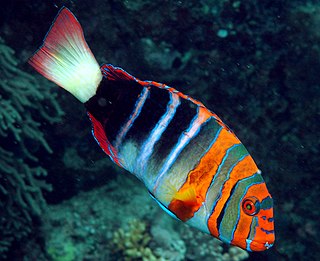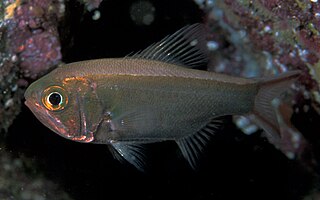
Shiner is a common name used in North America for any of several kinds of small, usually silvery fish, in particular a number of cyprinids, but also e.g. the shiner perch.

The pygmy shark, the second-smallest of all the shark species after the dwarf lanternshark, is a squaliform shark of the family Dalatiidae, the only member of the genus Euprotomicrus. Their lengths are up to about 25 cm (10 in) for females and about 22 cm (8.7 in) for males.

The pouched lamprey, also known as the piharau in the North Island, korokoro,kanakana in the South Island, or wide-mouthed lamprey, is a species in the genus Geotria, which is the only genus in the family Geotriidae. The second species in the genus is the Argentinian lamprey, which was revalidated as a separate species in 2020. The pouched lamprey is native to the southern hemisphere. It spends the early part of its life in fresh water, migrating to the sea as an adult, and returning to fresh water to spawn and die.

Bodianus or the hogfishes is a genus of fish in the family Labridae found in the Atlantic, Indian and Pacific Ocean. These species have many parasites.

Choerodon is a genus of wrasses native to the Indian Ocean and the western Pacific Ocean. They are commonly referred to as tuskfish, because most species have sharp tusk-like teeth.

McMillan's catshark is a species of shark belonging to the family Pentanchidae, the deepwater catsharks, in the order Carcharhiniformes. McMillan's catshark is a small, rare, and little-known deepwater shark that is endemic to New Zealand. It is found at depths of 985–1350m on the lower continental slope around New Zealand, on the West Norfolk Ridge, and off North Cape. It can grow to a length of 45 cm.
Asymbolus is a genus of catsharks in the family Pentanchidae, the deepwater catsharks.

Optivus is a fish genus from the family Trachichthyidae found from near the surface to depths of 320 m (1,050 ft) in the southwest Pacific Ocean off Australia and New Zealand.
The roughskin catshark is a species of catshark in the family Pentanchidae, the deepwater catsharks. This species is found near Australia and New Zealand. Its natural habitat is the open seas. This species belongs to a genus of poorly known deep-water catsharks.

Urolophus is a genus of round rays mostly native to the western Pacific Ocean and the Indian Ocean, though one species occurs in the Pacific waters of the Mexican coast. Müller and Henle erected Urolophus in an 1837 issue of Bericht Akademie der Wissenschaften zu Berlin. The name is derived from the Greek oura, meaning "tail", and lophos, meaning "crest". In Urolophus, the outer rims of the nostrils are not enlarged into lobes, but may form a small knob at the back.

Eptatretus is a large genus of hagfish.

The Aulopidae are a small family of aulopiform ray-finned fish. They are found in most tropical and subtropical oceans, such as the Atlantic, Mediterranean, and Pacific. The aulopids are commonly known as flagfins.

Lepidotrigla is a genus of marine ray-finned fishes belonging to the family Triglidae, the gurnards and sea robins. These gurnards are found in the Eastern Atlantic, Indian and Western Pacific Oceans.

Emblemariopsis is a genus of flagblennies found throughout the Atlantic ocean.
Neomyxine is a genus of hagfish found in the Pacific Ocean around New Zealand.

Aulopus is a genus of flagfins native to the Atlantic Ocean and the Pacific Ocean. Although Aulopus is native to both the Atlantic and the Pacific oceans, for the first time in 2010 Aulopus filamentosus, was spotted in Brazilian waters. A discovery like this may suggest that these fish can be found in new environments.

Hime is a genus of flagfins native to the eastern Indian Ocean and the western Pacific Ocean.

Hoplostethus is a genus of fish in the slimehead family.

Parapercis is a genus of sandperches belonging to the family Pinguipedidae.

Polylepion is a genus of wrasses native to the Pacific Ocean. It is also known as a bleeding wrasse. They are mostly found over sandy waters from Mexico to Nicaragua, including Cocos Island.
















